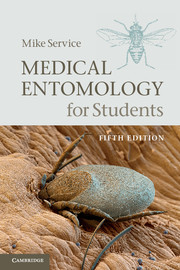Book contents
- Frontmatter
- Contents
- Preface to the first edition
- Preface to the second edition
- Preface to the third edition
- Preface to the fourth edition
- Preface to the fifth edition
- Acknowledgements
- 1 Introduction to mosquitoes (Culicidae)
- 2 Anopheline mosquitoes (Anophelinae)
- 3 Culicine mosquitoes (Culicinae)
- 4 Black flies (Simuliidae)
- 5 Phlebotomine sand flies (Phlebotominae)
- 6 Biting midges (Ceratopogonidae)
- 7 Horse flies (Tabanidae)
- 8 Tsetse flies (Glossinidae)
- 9 House flies and stable flies (Muscidae) and latrine flies (Fanniidae)
- 10 Flies and myiasis
- 11 Fleas (Siphonaptera)
- 12 Sucking lice (Anoplura)
- 13 Bedbugs (Cimicidae)
- 14 Triatomine bugs (Triatominae)
- 15 Cockroaches (Blattaria)
- 16 Soft ticks (Argasidae)
- 17 Hard ticks (Ixodidae)
- 18 Scabies mites (Sarcoptidae)
- 19 Scrub typhus mites (Trombiculidae)
- 20 Miscellaneous mites
- Appendix Names of some chemicals and microbials used in vector control (with common trade names in parentheses)
- Glossary of common terms relevant to medical entomology
- Select bibliography
- Index
- Plate section
- References
6 - Biting midges (Ceratopogonidae)
Published online by Cambridge University Press: 05 June 2012
- Frontmatter
- Contents
- Preface to the first edition
- Preface to the second edition
- Preface to the third edition
- Preface to the fourth edition
- Preface to the fifth edition
- Acknowledgements
- 1 Introduction to mosquitoes (Culicidae)
- 2 Anopheline mosquitoes (Anophelinae)
- 3 Culicine mosquitoes (Culicinae)
- 4 Black flies (Simuliidae)
- 5 Phlebotomine sand flies (Phlebotominae)
- 6 Biting midges (Ceratopogonidae)
- 7 Horse flies (Tabanidae)
- 8 Tsetse flies (Glossinidae)
- 9 House flies and stable flies (Muscidae) and latrine flies (Fanniidae)
- 10 Flies and myiasis
- 11 Fleas (Siphonaptera)
- 12 Sucking lice (Anoplura)
- 13 Bedbugs (Cimicidae)
- 14 Triatomine bugs (Triatominae)
- 15 Cockroaches (Blattaria)
- 16 Soft ticks (Argasidae)
- 17 Hard ticks (Ixodidae)
- 18 Scabies mites (Sarcoptidae)
- 19 Scrub typhus mites (Trombiculidae)
- 20 Miscellaneous mites
- Appendix Names of some chemicals and microbials used in vector control (with common trade names in parentheses)
- Glossary of common terms relevant to medical entomology
- Select bibliography
- Index
- Plate section
- References
Summary
There are almost 5800 species of biting midges in about 125 genera, but only four genera have species feeding on vertebrates. Medically the most important two genera are Leptoconops, which is mainly found in the tropics and subtropics, including the Caribbean area and parts of the USA, and Culicoides, which has an almost worldwide distribution. In many parts of the world species of Culicoides, and in the Americas also Leptoconops, can constitute serious biting problems. Culicoides species are vectors of filarial worms, such as Mansonella perstans and Mansonella streptocerca in Africa, while Culicoides furens is a vector of Mansonella ozzardi in the Americas. All these parasites are usually regarded as non-pathogenic to humans. Although many Leptoconops species are biting pests they are not usually important disease vectors.
The only virus transmitted to humans by biting midges is Oropouche virus in the Americas.
Adults are sometimes known as midges or biting midges, and, especially in the Americas, as ‘no-see-ums’. In Australia and some other countries they are often called sand flies, but this name is unfortunate and should be avoided because phlebotomines (Chapter 5) and occasionally simuliids (Chapter 4) may also be referred to as sand flies. The most appropriate common name is biting midges; this terminology serves to distinguish them from other small non-biting flies which are often referred to as midges.
- Type
- Chapter
- Information
- Medical Entomology for Students , pp. 108 - 115Publisher: Cambridge University PressPrint publication year: 2012



